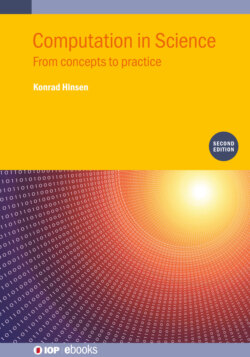Читать книгу Computation in Science (Second Edition) - Konrad Hinsen - Страница 5
На сайте Литреса книга снята с продажи.
Preface
ОглавлениеIn the course of only a few decades, computers have revolutionized scientific research and have become indispensable tools for both experimentalists and theoreticians. More and more scientists are writing computer programs for doing their work, and practically all scientists today use computer programs written by somebody else. Sometimes they do so without even being aware of it, in particular when these programs are integrated into lab instruments.
In spite of the ubiquitous use of computers in science, few researchers in the natural sciences have any formal training in computer science, software engineering, or numerical analysis. They usually acquire their computing knowledge ‘on the job’, and as a consequence it is usually limited to the practical knowledge required for applying computational tools. A big part of this practical knowledge is about specific computing technologies which, given the fast pace of change in this field, tend to be short-lived. Scientists often feel overwhelmed by the amount of computing knowledge they have to absorb, while at the same time lacking a solid understanding of the basic principles of the field.
The goal of this book is to explain these basic principles, and to show how they relate to the tasks of a scientistʼs daily work in the research lab. It provides a high-level overview of those aspects of computer science and software engineering that are most relevant for computational science, using a language familiar to scientists, and places them into the context of scientific computing. References to the literature are provided for readers wishing to study a particular aspect in more depth. My hope is that this book will allow its readers to use computers with more confidence, and to see computing technologies in a different light, evaluating them on the basis of how they contribute to doing better science.
The intended audience for this book includes both graduate students and experienced scientists. Some hands-on experience with computing is highly desirable, but no competence in any particular computing technology is expected. Most of this book is relevant to all of the natural sciences. The frontier between the physical and the life sciences is blurring, and computation plays a big part in this change. An interdisciplinary approach to computational science therefore seems the most appropriate one for the 21st century. Its main drawback is that some misunderstandings are inevitable. Even a term as basic as ‘theory’ or ‘model’ can have different meanings in different fields. My own background in theoretical physics will certainly show through occasionally. If anything I say seems strange or wrong, please consider that this may just reflect a cultural difference.
The website at http://computation-in-science.khinsen.net/ contains complementary material to this book, in particular references to on-line material that I consider of interest for my readers. I will regularly add new references that I discover and remove links that no longer work.
